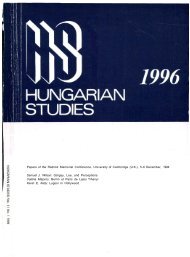Korall 7-8. (2002. március) - EPA - Országos Széchényi Könyvtár
Korall 7-8. (2002. március) - EPA - Országos Széchényi Könyvtár
Korall 7-8. (2002. március) - EPA - Országos Széchényi Könyvtár
You also want an ePaper? Increase the reach of your titles
YUMPU automatically turns print PDFs into web optimized ePapers that Google loves.
250Szegedi, Péter: „If I had my bayonet with me, I would stab him through!”Football violence in the interwar period in East-HungaryThe study intends to show that Hungarian football in the interwar period did not atall lack violence; actually, the occurrence of several characteristic phenomena was morefrequent than today. The 1921 act issued by the minister of internal affairs for controllingfootball violence had an all-European echo; police could interfere in matches; and bythe end of the year spectators were banned from all Budapest matches for an unspecifiedperiod of time.In the period between the two World Wars, in the eastern part of the country only,incidents of different kinds and seriousness have intruded in nearly hundred cases intothe order of matches or following the meetings. This region was the most infected areaby football violence, the news of which has even reached Paris. The study, based onnumerous contemporary reports, presents cases of violence between players, betweenspectators and also cases in which spectators have attacked opponent players or thereferee. Apart from elaborating on the different types of incidents, the study attemptsto present who and for what reasons have launched these attacks and also, why thenumber of violent cases grew exactly after the war. According to the author’s hopes, bythis, the study will also highlight how the war affected norms of behavior – and willsupply an important contribution to the historical embedding of Elias’ theory oncivilization and Durkheim’s theory on anomy.Zeidler, Miklós: An old playing field in the age of the middle classes – the MillenarySports EstablishmentThe study presents the history of the first modern rally field in Budapest, the MillenarySports Establishment, built in 1896. The field was planned to become the setting for theopen-air sports events that were part of the millenary celebrations. According to theinitial plans, it was to be dismantled after the end of the year. Still, considering that thecapital provided over no other sporting field of similar quality, and that rally sport wasdeveloping spectacularly, the field first received temporary maintenance permissionand later evolved as the permanent official rally field. Along athletics and cycling, thenew sports branch, football was also made a home there. The Hungarian nationalfootball team played its national games there between 1901 and 1911, from the beginningsuntil the completion of the big club stadiums.Although the field was one of the central sites of the Budapest sport life in the firsthalf of the century, the World War, the world economic crisis and the financial problemsarising from the changing popularity of the specific sports branches more than oncedrove the Millenary, that was supported from time to time by new investors (clubassociations, profit oriented organizers of competitions, the city council or the stateitself) close to liquidation.
















